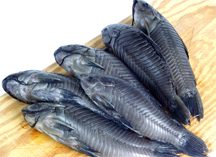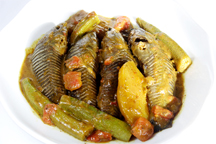Hi Everyone,
“Those who eat the Cascadura will, the native legend says, wheresoever they may wander end in Trinidad their days,” Johnson and the Cascadura (Selvon, 1957).
So goes the folklore in Trinidad and Tobago about this rare, prized member of the catfish family, known in Guyana and Brazil as hassar and as cascadura or cascadoo in Trinidad and Tobago.
I know of no legends or folktales in Guyana about this fish, what I do know, however, is that we love hassar very much and even though the vendors often demand an unreasonable price for a few of these fish, we nevertheless reach deep into our pockets because there is nothing quite like hassar curry cooked with coconut milk, lots of tomatoes, a few pieces of green mango, several okra and if you can find some, a few sticks of saijan (drumsticks). The only accompaniments for this curry are hot white rice and lots of pepper sauce or achar. Don’t even think about eating with a spoon, a knife and fork would be laughable; the only tool you have to use is of the God-given variety, your hands!
 According to the Institute of Marine Affairs, hassar, Hoplosternum littorale, is found naturally from northern South America to Central America; it occurs locally in the lower reaches of most of the rivers south of the Northern Range. This fish with its own protective armour of two rows of bony plate-like scales is found in fresh water swamps during the dry season. As the water recedes, catching hassar is easy. Some fisherfolk use a cast-net, some hook and line while others use the trapping method.
According to the Institute of Marine Affairs, hassar, Hoplosternum littorale, is found naturally from northern South America to Central America; it occurs locally in the lower reaches of most of the rivers south of the Northern Range. This fish with its own protective armour of two rows of bony plate-like scales is found in fresh water swamps during the dry season. As the water recedes, catching hassar is easy. Some fisherfolk use a cast-net, some hook and line while others use the trapping method.
“Don’t tell me you’re going fishing with a bucket and a basket,”
“Wait and see.”
There are two ways to catch the cascadura. One is to dam the muddy area where you suspect they are, and bail out the water and pick them up floundering in the mud. The other is to look for a spot where twigs and leaves and other odd debris float down and form an island near a calm part of the steam. Under such shelter the cascadura lays its eggs. All you have to do is to dip your bucket partly into the water, so that you cover the nest, and splash the water near the basket. When the fish hears the noise it leaps towards it, and you catch him in your basket and drain off the water, and you’ve landed your first cascadura. Johnson and the Cascadura (Selvon, 1957)
 Eating hassar for me is all about the bones, I love to suck on them and the head of the hassar is one of the best parts. Once cooked, the outer shell literally slides off the fish to reveal a firm tan-coloured flesh. For me, eating hassar is never a one-fish deal; three is the number that satisfies me at each sitting. This is how I think about it. The first one is to whet my appetite, the second one is to satisfy the taste buds that yeah, I’m eating hassar and the third one, is to wrap things up, like a good story, it has a beginning, middle and an end.
Eating hassar for me is all about the bones, I love to suck on them and the head of the hassar is one of the best parts. Once cooked, the outer shell literally slides off the fish to reveal a firm tan-coloured flesh. For me, eating hassar is never a one-fish deal; three is the number that satisfies me at each sitting. This is how I think about it. The first one is to whet my appetite, the second one is to satisfy the taste buds that yeah, I’m eating hassar and the third one, is to wrap things up, like a good story, it has a beginning, middle and an end.
Growing up I always knew that hassar came from the countryside and Berbice seemed to be the place to get the best hassar. That may be so because I know more people in Berbice than I do in Essequibo. (For my non-Caribbean readers, Guyana is divided into three main counties, Demerara, Berbice and Essequibo).
Even now, my brother, knowing how hard it is to get hassar here in Barbados will tell me teasingly of the fresh, big hassar he bought in Berbice and how he is heading home to cook a hassar curry. Or my mother or sister would say, “Girl, we going over by your brother, he just come from Berbice and he cooking hassar curry.” All I could do at those torturous times is wish I could partake in the meal.
Of course the best way to eat fish among many things is fresh and hassar in Guyana and Trinidad and Tobago is usually sold fresh in the markets or if you live in the country areas, you can always hear fisherfolk passing by yelling that they have hassar for sale. These days, however, for those of us living abroad and longing for a taste of home, the freezer section in an ethnic supermarket is where we head for such fare or you head to the “fish guy” in the market with the big ice coolers loaded with seafood from back home. I cannot tell you how excited I was to discover my own fish guy here in Barbados. It has taken me this long to tell you about it because I was selfish; I wanted to keep this knowledge to myself. I was proud that I had my own fish guy who could get me hassar right here in Barbados! My, how times and things have changed, you can get almost everything in most parts of the world where there is an immigrant population.
The demand for hassar has always been more than the supply and it doesn’t help that some fisherfolk also take the egg-masses from the breeding nests for food thus resulting in the dwindling of the natural stock. Hassar like many other fish is now being farmed and while I understand the need to feed the demand that carries a good market price, I only want to eat hassar when it is in season. What about you?
Cynthia
tasteslikehome@gmail.com
www.tasteslikehome.org
Johnson and the Cascadura (a synopsis)
By Sam Selvon
Johnson and the Cascadura is a fictional short story about a white Englishman, Garry Johnson, who went to Trinidad “to get background material for a book he was writing, on superstition and witchcraft.” While there, Johnson met an Indian girl, Urmilla, who worked on the estate where Johnson was staying. The two fell in love. They were from different worlds, he a white, affluent man, and she an uneducated country girl. Rumours of their love circulated and there was disquiet and disapproval.
Johnson decided to return to England. The night before he was due to return, Urmilla brought him some curry cascadura she had made, believing in the folklore that, “Those who eat the cascadura will, the native legend says, wheresoever they may wander end in Trinidad their days.”
Johnson returned to England and wrote his book. Three years later, he was diagnosed with a rare blood disease. Doctors did not give him much time to live and so he wanted to go back to Trinidad.
Upon his return, Johnson and Urmilla began planning their wedding. Sam, the overseer who had unrequited love for Urmilla said to Johnson, “So the cascadura legend really worked, and brought you back to Trinidad.”
“I can’t get Urmilla to believe otherwise,” Johnson laughed.
Urmilla was positive that the cascadura had worked the charm.








